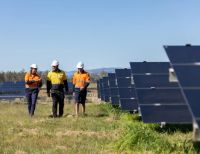Fewer young people have the means to buy their first home, but is there a way to shortcut a failing system?
‘Rent to buy’ (or ‘rent to own’) and ‘Build to Rent to Buy’ (BtRtB) are being seen as possible solutions to add to the housing mix. Photo: Unsplash.
If you’re an Australian born after 1995 it’s increasingly unlikely you’ll be buying your home anytime soon.
The 2021 Census confirmed what had been suspected: the number of people aged between 30 and 34 who owned their own house, had slipped to just 50 percent.
That’s a drop of 14 percent in 50 years. The age when people typically first buy a home has gone up from 26 to 32.
With young people facing seemingly insurmountable hurdles to home ownership, policymakers are scrambling to address the problem.
While many of the ideas being floated to help fix the crisis have been around for a while, there are some gaining renewed interest. Among them, ‘Rent to buy’ (or ‘rent to own’) and ‘Build to Rent to Buy’ (BtRtB) are being seen as possible solutions to add to the housing mix.
Rent to buy and its new variant forms
The basic ‘rent to buy’ (RtB) idea is simple: the aspiring first home buyer leases their dwelling while saving to eventually buy it. Both rent and ensuing purchase price are usually fixed at the start, providing housing stability during the savings period. But there are hazards.
Rent to buy schemes are generally offered by developers and property companies on the basis that you pay a market rent for your home, plus an additional fee for the option to buy it later. However, depending on the exact terms of your agreement, this can place you at risk of forfeiting your excess rent credit if the property’s value fails to increase as expected. Similarly, you may face difficulties in securing a mortgage if the property turns out to be overpriced at the point of purchase.
Historically, many rent to buy offers were dangerously risky for renter/buyers as, in an unregulated market, customers were open to exploitation by unscrupulous operators. Recognising this hazard, the state of Victoria recently clamped down by introducing new consumer protections: option fees must be banked, and either go to the purchase price or be refunded. But these rules have yet to be adopted nationwide.
A new RtB variant that has recently emerged in Australia is the ‘Build to Rent to Buy’ (BtRtB) model; where the home to be acquired is newly constructed for the purpose. Offering a version of BtRtB as a market product without explicit state support, Assemble Communities has attracted attention for its ongoing plan to generate 450 units on three Melbourne sites.
A government-backed version of BtRtB has been developed by the Commonwealth Government’s National Housing Finance and Investment Corporation (NHFIC). This factors in a community housing provider as property developer and manager until the tenant takes full ownership after 10 years (if possible). It seeks to use the (assumed) growth in the occupied property value as a contribution to the occupier’s eventual mortgage deposit.
The NHFIC model is now being piloted by Community Housing Canberra, particularly targeting older women in housing stress or at risk of homelessness.
Alternative forms of first home buyer assistance
Build to rent to buy is interesting as an innovative new approach, but in terms of scale, the most significant recent Australian development in this area has been the huge expansion in the provision of government-backed low-deposit mortgages.
That resulted from the Morrison Government’s 2020 launch of its First Home Loan Deposit Guarantee Scheme — now the NHFIC First Home Guarantee program. This emulates initiatives long-established in Western Australia and South Australia.
By effectively insuring the mortgage lender against possible borrower default, the government enables qualifying applicants to secure their housing loan for 5 percent deposit rather than the standard 20 percent. While this doesn’t make home ownership affordable for lower income households, it does offer moderate income earners the chance to achieve it much more quickly.
Potentially more effective in enabling slightly lower-income households to access home ownership is the shared equity model. This involves a qualifying first home buyer benefiting from a third party stake in their acquired property. This share, typically around 30 percent, is held by a developer or government agency under a second mortgage.
The buyer, meanwhile, can secure their home for a 30 percent smaller mortgage than would be otherwise needed; this at the cost of sharing subsequent capital gains with the co-investor. When the buyer sells or refinances their home, the third party equity is reclaimed, ideally for re-issuance to a new scheme participant.
As well as the shared equity programs already operated by Western Australia, South Australia and Victoria, the Commonwealth Government has pledged to establish a national shared equity scheme named ‘help to buy’. A number of privately-initiated schemes have also been recently launched.
Limitations of first home buyer assistance
These types of schemes complement the cash grants and stamp duty concessions which were, until quite recently, the overwhelmingly dominant forms of first home buyer assistance in Australia. They have the advantage of being less inflationary and more cost-effective than those longer-established schemes.
A new comparative analysis has also assessed shared equity as more advantageous than RtB from the perspective of both residents and investors.
But none of these models does much to bring first home ownership within reach for people otherwise permanently excluded from it by inadequate means. Instead, for most, the main effect is the somewhat lesser gain of bringing forward home ownership for moderate income earners.
This limitation links to the wider concern that sustainable home ownership growth demands systemic change to tackle the much tougher challenge of easing Australia’s broader housing affordability problem.
Thanks to Dr Chris Martin, UNSW, for input into this story.
Hal Pawson is a Professor of Housing Research and Policy and Associate Director at UNSW’s City Futures Research Centre and lead author of the Assisting first homebuyers: an international policy review report.
Professor Pawson has received funding from the Australian Housing and Urban Research Institute to undertake some of the research referred to in this article.
Originally published under Creative Commons by 360info.














